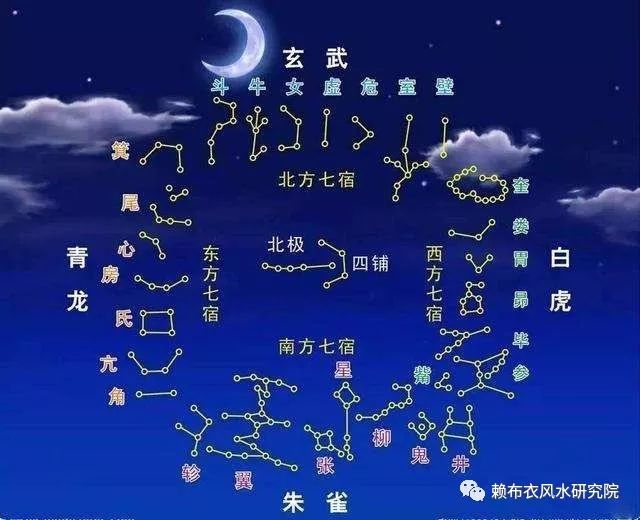28 Chinese constellations
28 Lunar Mansions (in Chinese: 二十八宿, Ershibasu, or written with the single character 廿八宿, Nianbasu) make a system of 28 constellations in the Chinese lunar zodiac. It is also a system for selecting auspicious dates based on the Moon position of each day.
The Chinese lunar mansions share some similarities with the Western zodiacal constellations, but they are smaller in scale. While in Western astronomy there are 12 zodiacal constellations, in the Chinese lunar zodiac there are 28. Like the zodiacal constellations of Western astronomy, the 28 constellations of the Chinese lunar zodiac are positioned along the ecliptic in the sky. These constellations are divided into four groups, known as the "Four Celestial Animals": the Azure Dragon, the Black Tortoise (or Warrior), the White Tiger, and the Vermilion Bird. These lunar mansions form the basis of one of the most important date selection systems associated with the Chinese calendar and the Tung Shu almanac in Feng Shui practice.
Enable your Personal Chinese Fortune Calendar and receive personalized information about the auspiciousness of days and hours based on your own Bazi horoscope".
Since the constellations represent places in the sky where the Moon "resides" each night, similar to different houses, the 28 constellations are also referred to as the "28 Lunar Mansions," "28 Lunar Houses," or "28 Xiu." The term "Xiu" (宿), (a Mansion, a House) itself can refer to either the 28 constellations of the lunar zodiac or to the 28 sectors of the sky containing these constellations.
As the Moon travels across the celestial sphere, it passes through approximately one constellation each day. Therefore, each day in the lunar cycle of 28 days corresponds to the influence of one of the constellations. In reality, the sectors corresponding to the 28 constellations vary in size, and the constellations are unevenly distributed along the ecliptic. The smallest, Jui (Beak, Tortoise), occupies only 11°, while the largest, Well, occupies 33°. Consequently, the Moon "resides" in each constellation for varying durations, ranging from a couple of hours to two days. Moreover, alongside the actual constellations, Chinese metaphysics also utilizes lunar days and lunar mansions-signs, which are equal in size. The average size of these mansions is approximately 360/28, or about 13°.

In the system of selecting auspicious dates based on the "28 Lunar Mansions," it is conventionally accepted that the Moon passes through exactly one constellation (mansion) per day. Therefore, in date selection, we do not use the actual 28 lunar mansions of varying sizes, but rather the symbolic 28 lunar mansions, each of which corresponds precisely to one calendar day. This results in a repeating 28-day cycle. In the traditional calendar, the influence of the lunar mansions, known as "Xiu," is attributed not only to days but also to years. This is because Saturn, a very important planet in Chinese astrology and metaphysics, is believed to complete its orbit around the Sun (and consequently, its path along the ecliptic and the 28 lunar mansions) approximately every 28 earthly years
Discover the secrets of luck—download the free "Feng Shui Fortune Calendar" app from Google Play or the App Store and easily choose auspicious days for any activity right from your phone!
Some date selection specialists refrain from using the method of the "28 Lunar Mansions," citing the astronomical imprecision of the conditional alignment of constellations with days. Professional Chinese astrologers often utilize real Lunar Mansions rather than symbolic ones in their calculations, but these methods are highly complex and not easy to employ. However, the "28 Lunar Mansions" are referenced in many editions of the traditional Chinese calendar and are prominently featured in the Tung Shu almanac. The method of the 28 Lunar Mansions is also mentioned in the "Treatise on Harmonizing Times and Distintuishing Directions" (協記辯方書 - Xie Ji Bian Fang Shu).

System of 28 Lunar Mansions in Tung Shu almanac
In this calendrical system used on our website, it is conventionally accepted that the influence period of each Xiu (Lunar Mansion) spans exactly one day, commencing at the same time as the Chinese day, which starts at midnight.
The cycles of the 28 Lunar Mansions do not align with the Chinese calendar months, whether lunar or solar, due to their differing durations. Additionally, since 28 is divisible by 7, there is a certain correlation between the "Xiu" and the days of the week. For instance, only four Lunar may correspond to Sunday: 4. House (房 - Fang), 11. Void/Emptiness (虛 - Xū), 18. Pleiades/Hairy Head (昴 - Mǎo), and 25. Star (星 - Xīng).
The 28 Xiu roughly correspond to the "lunar mansions" or "lunar zodiac" in Western Arabic astrology. They are also recognized in the astronomy of other countries: in Japanese, the system is called にじゅうはっしゅく (Nijuhasshuku), in Korean 이십팔수 (Issipbalsu), and in Sanskrit नक्षत्र (Nakshatra).